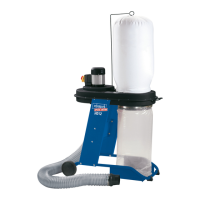www.scheppach.com / service@scheppach.com / +(49)-08223-4002-99 / +(49)-08223-4002-58
11 / 16
6. Technical data
Technical Data
Dimensions L x W x H
(mm):
830 x 520 x 1600
Overall height with
lter bag mm
1600
Ectractor duct
connections ø mm
100
Hose length mm
2300
Wheel diameter mm
150
Approx. weight kg
20
Rate of air ow m
3
/h
1150
Pressure differential
Pa
1600
Filter aera (lter bag)
m
2
approx. 1
Sawdust bag capacity
litres
75
Performance
Electric motor
230-240 V/5O Hz
Nominal input P1
0,55 kW
Output power P2
0,34 kW
Motorspeed 1/min.
2850
Work Place Emissions Values:
Empty Run Noise dB
(A)
75,5
Working Noise dB (A)
75,5
7. Assembly
For packaging reasons your machine is delivered in
semi-assembled state.
• Attach the side covering loosely to the base
frame using at-head screws M8 x 40 mm and
screw nuts. Do not tighten completely. Fig. 2, 3
• Attach the cross-member to the side covering
left and right with at-head screws M 8 x 12 and
screw nuts. Fig. 4, 5
• Remove 4 off the 6 screws (Motor end of the hous-
ing) on the blue metal plates bolted to each side
of the housing, As shown by the arrows in g.6
on page 4
• Attach the housing to the side coverings using the
4 Screws, washers and nuts previously removed.
• Securely tighten ALL base nuts and bolts now.
• Position the upper bag support bar into the hous-
ing and hang the cloth lter bag from it. Fig. 7
• Slide the longest bag clamp through the sleeve
on the bottom of cloth lter bag.
• Fix the top cloth lter bag on the container. Fig. 7
• Attach the plastic shavings bag to the lower air
ventilator using the shorter (1050mm) bag clamp.
Fig. 7
• Attach the exhaust hose to the nozzle on the
housing and afx it with a hose clamp. Fig. 8
• Attach the hose coupling to the other end of the
hose using a hose clamp. Fig. 9
• Do not use any low-powered machines for heavy
duty work.
• Do not mis-use the cable
• Make sure you stand squarely and keep your ba-
lance at all times.
• Check that the moving parts are in good working
order, that they do not jam, and that no parts are
damaged. Make sure that all parts are tted cor-
rectly and that all other operating conditions are
properly fullled.
• Unless otherwise stated in the operating instruc-
tions, damaged safety devices and parts have to
be repaired or replaced by an authorized service
center.
• Have damaged switches replaced by a customer
service workshop.
• This electric tool complies with the pertinent safety
regulations. Repairs are to be carried out only by
a qualied electrician using original replacement
parts or the user may suffer an accident.
• If necessary, wear suitable personal protection
equipment. This could consist of:
- Ear-muffs to prevent the risk of damaging your
hearing
- A breathing mask to prevent the risk of inhaling
hazardous dust
• The operator has to be informed about the condi-
tions with an inuence on noise development.
• Faults on the machine have to be reported to the
person in charge as soon as they are discovered.
• This appliance is not suitable for the collection of
dangerous dust.
• This equipment is not designed to be used by peop-
le (including children) with limited physical, sensory
or mental capacities or those with no experience
and/or knowledge unless they are supervised by a
person who is responsible for their safety or they
have received instructions from such a person in
how to use the equipment safely. Children must al-
ways be supervised in order to ensure that they do
not play with the equipment.
Remaining hazards
The machine has been built using modem techno-
logy in accordance with recognized safety rules.
Some remaining hazards, however, may still exist.
• Wood chips and sawdust can be health hazards.
Be sure to wear personal protective gear such as
safety goggles and a dust mask.
• Dust inhalation may occur when closing and replac-
ing the dust bag.
• Please note the instructions concerning proper dis-
posal in the operating manual (e.g. the use of P2
dust masks) to prevent dust inhalation.
• Noise can be a health hazard. The permitted noise
level is exceeded when working. Be sure to wear
personal protective gear such as ear protection.
• The use of incorrect or damaged mains cables can
lead to injuries caused by electricity.
• Even when all safety measures are taken, some re-
maining hazards which are not yet evident may still
be present.
• Remaining hazards can be minimized by following
the instructions in “Safety Precautions”, “Proper
Use“ and in the entire operating manual.
Keep this safety information in a safe place.
GB
Instructions Manual for HD12 (W886)

